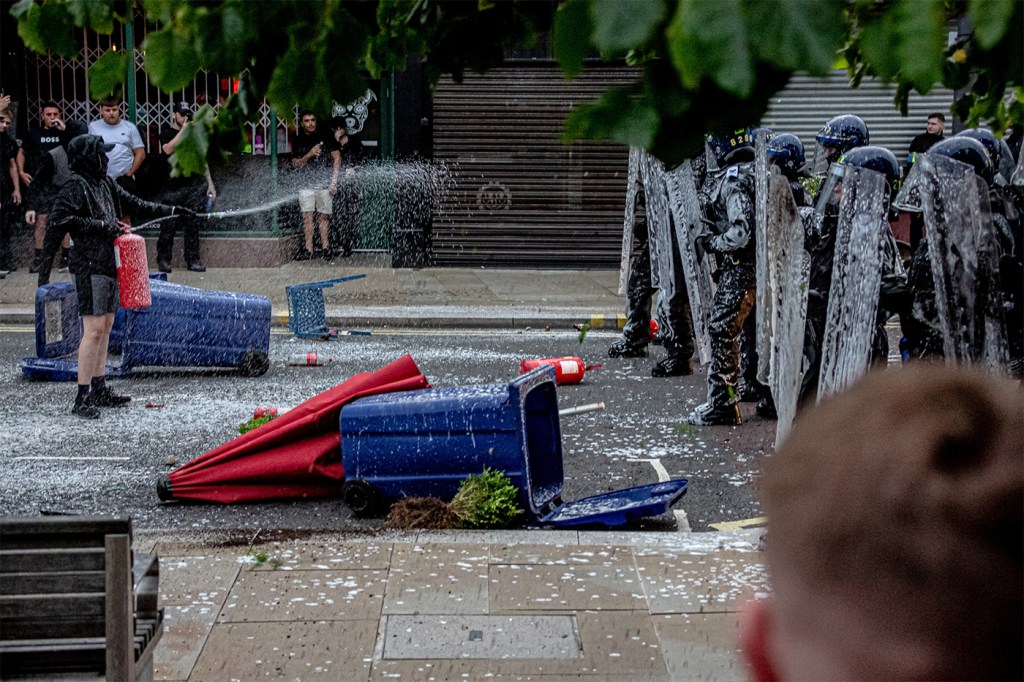What is mob mentality? Experts explain how it’s contributing to the UK protests and riots
Northeastern experts unpack what is driving the disruptive behavior seen on Britain’s streets in the aftermath of the Southport knife attack.

LONDON — Britain is braced for further violence and rioting, with 6,000 police mobilized to deal with about 100 anti-immigration protests planned across the country.
The week-long protests have been sparked by misinformation spread in the wake of a knife attack that killed three young girls at a Taylor Swift-themed dance party in Southport, England.
It was falsely claimed online that the 17-year-old arrested by police in relation to the stabbings was an asylum seeker.
Hossein Dabbagh, an assistant professor in applied ethics at Northeastern University, says far-right groups have used what happened in Southport “to push their agendas” and “tap into broader societal anxieties about crime, immigration and national identity.”
Dabbagh explains that the destructive group behavior seen during the recent protests and the subsequent rioting can best be described as a form of “mob mentality” or “deindividuation.”
Following a demonstration in Sunderland, protesters torched a police station, while 100 miles south in Hull, protesters shouted, “We want our country back,” before looters went on to raid shoe shops, technology stores and even bakeries.
In Rotherham, protesters appeared to attempt to set fire to a hotel housing asylum seekers.
“Deindividuation occurs,” says Dabbagh, “when individuals feel anonymous within a group, leading to a loss of self-awareness and diminished personal responsibility.
“When people become part of a large, emotionally charged crowd, the usual social constraints that regulate individual behavior can weaken. Actions become driven more by the collective emotions of the group than by personal morals or ethics.
“The fear, anger and frustration stoked by online falsehoods created an environment where many felt justified in participating in the riots, even though their actions were destructive and harmful.”
Misinformation in a social media age
Laura Edelson, an assistant professor and misinformation expert at Northeastern, says British media laws appear lacking in their ability to counter misinformation in a social media age in which “everyone is now a journalist.”
Official attempts to dispel false information concerning the background of the Southport suspect were hampered by U.K. legal convention that advises against the public naming of a suspect yet to be charged and a law providing anonymity to defendants under the age of 18 — the legal threshold for adulthood in the U.K.
Featured Posts
Two days after the attack, a judge took the unusual step of lifting the anonymity order — the suspect was named as Axel Rudakubana — in a bid to stop further misinformation spreading and the fact that the accused was about to become an adult within days.
But the decision came too late to reverse the deluge of anti-immigration and anti-Muslim rhetoric that had taken off online.
“In this example, there was the thing that everybody wanted to know,” Edelson says. “The information demand was: ‘Was the alleged perpetrator an asylum seeker?’
“There was a lot of demand for that piece of information and there was no legitimate supply of that information. What has happened is we now have a free market for information.
“What that means is, if there is demand, supply will rise up to fulfill that information demand. And if those in the mainstream media are not willing or able to supply that information, other people will.
“People are asking, ‘Why would anyone do this [spread misinformation]?’ It is because there is demand and they are fulfilling that demand — and there are rewards for doing so.”
Edelson says that those spreading misinformation might have been aware that what they were putting out was false but that it reinforced what they hold as a “core belief.”
“They do it because they think there is some core truth that they are getting at with this incorrect fact pattern,” she explains. “It reinforces something that they themselves already believe.”
Far-right in Britain has evolved
Marianna Griffini, a London-based Northeastern expert on extremism, says the far-right in Britain has evolved over time.
Centrally organised groups, such as the anti-Islam English Defence League, have “faded into irrelevance” and instead have been replaced by less defined “movements” that are mostly active online, she states.
According to Griffini, the protests seen in the aftermath of the Southport tragedy seem to be less driven by a coherent ideology —such as fascist or neo-Nazi political beliefs — and more by social and economic grievances, particularly felt by those in Britain’s white working-class communities.
“What prompted these people to act was apparently fake news [about the Southport defendant’s identity],” she says. “It appealed to an ideological terrain of carrying grievances, of resentment against the government but also against whoever is different from an ethno-cultural point of view.
“If you ask the protesters, ‘What do you want?’ It would be to drive immigrants out. They want to recreate a homogeneous white Britain, whatever that has come to mean over the past 60 years.”
Griffini points out that the demonstrations have mostly been focused in Brexit-voting areas. The assistant professor in international relations and anthropology says part of what can attract young white males to join these protests is “the appeal of violence.”
“I do not think that they consciously identify with an ideology,” she says. “I’m not sure of the extent to which they are completely aware of the values and principles that they seem to be fighting for.
“This is underground. It is not about canvassing or going door-to-door; it is not about organizing a town hall meeting. It is not about doing politics according to its true meaning — to deliberate, discuss, compromise and have dialogue.
“It is instead something that is behind the curtain and beyond what is permitted in the political mainstream, which does not allow for activism to become extreme, violent or even terrorism.”











